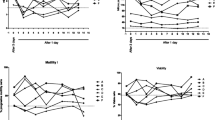The purpose of this study was to find out whether the seminal testosterone and/or estradiol levels could serve as prognostic criteria for normal spermatogenesis and whether they are able to characterize the sperm pathology. The study involved healthy young male volunteers (n=269); serum and seminal steroid hormones were measured; the sperm concentration, mobility, and morphology were evaluated. The results indicate that the seminal testosterone concentration is lower (p<0.05) and the seminal estradiol is higher than the corresponding parameters in the serum (p<0.05). The seminal testosterone and estradiol concentrations negatively correlated with the sperm concentration, and the seminal estradiol concentration was higher in pathozoospermic than in normospermic men (p<0.05). It is assumed that the seminal estradiol level can be an indicator of sperm quality and serve as a biological predictor of normal spermatogenesis; in addition, this parameter can be used for diagnostic purposes in patients with impaired spermatogenesis induced by excess of estrogens.
Similar content being viewed by others
References
Rodriguez-Martinez H, Martinez EA, Calvete JJ, Peña Vega FJ, Roca J. Seminal Plasma: Relevant for Fertility? Int. J. Mol. Sci. 2021;22(9):4368. https://doi.org/10.3390/ijms22094368
Vitku J, Kolatorova L, Hampl R. Occurrence and reproductive roles of hormones in seminal plasma. Basic Clin. Androl. 2017;27:19. https://doi.org/10.1186/s12610-017-0062-y
Hampl R, Kubátová J, Sobotka V, Heráček J. Steroids in semen, their role in spermatogenesis, and the possible impact of endocrine disruptors. Horm. Mol. Biol. Clin. Investig. 2013;13(1):1-5. https://doi.org/10.1515/hmbci-2013-0003
Ramaswamy S, Weinbauer GF. Endocrine control of spermatogenesis: Role of FSH and LH/ testosterone. Spermatogenesis. 2015;4(2):e996025. https://doi.org/10.1080/21565562.2014.996025
Jørgensen N, Joensen UN, Toppari J, Punab M, Erenpreiss J, Zilaitiene B, Paasch U, Salzbrunn A, Fernandez MF, Virtanen HE, Matulevicius V, Olea N, Jensen TK, Petersen JH, Skakkebæk NE, Andersson AM. Compensated reduction in Leydig cell function is associated with lower semen quality variables: a study of 8182 European young men. Hum. Reprod. 2016;31(5):947-957. https://doi.org/10.1093/humrep/dew021
Osadchuk L, Tipisova E, Kleshchev M, Gorenko I, Osadchuk A. Study of Semen Quality, Reproductive Hormone Levels, and Lipid Levels in Men From Arkhangelsk, a City in North of European Russia. Am. J. Mens Health. 2020;14(4):1557988320939714. https://doi.org/10.1177/1557988320939714
Zhang Q, Bai Q, Yuan Y, Liu P, Qiao J. Assessment of seminal estradiol and testosterone levels as predictors of human spermatogenesis. J. Androl. 2010;31(2):215-220. https://doi.org/10.2164/jandrol.109.007609
Vitku J, Sosvorova L, Chlupacova T, Hampl R, Hill M, Sobotka V, Heracek J, Bicikova M, Starka L. Differences in bisphenol A and estrogen levels in the plasma and seminal plasma of men with different degrees of infertility. Physiol. Res. 2015;64(Suppl. 2.):S303-S311. https://doi.org/10.33549/physiolres.933090
Collodel G, Signorini C, Nerucci F, Gambera L, Iacoponi F, Moretti E. Semen Biochemical Components in Varicocele, Leukocytospermia, and Idiopathic Infertility. Reprod. Sci. 2021;28(1):91-101. https://doi.org/10.1007/s43032-020-00260-0
Zufferey F, Rahban R, Garcia A, Gagnebin Y, Boccard J, Tonoli D, Jeanneret F, Stettler E, Senn A, Nef S, Rudaz S, Rossier MF. Steroid profiles in both blood serum and seminal plasma are not correlated and do not reflect sperm quality: Study on the male reproductive health of fifty young Swiss men. Clin. Biochem. 2018;62:39-46. https://doi.org/10.1016/j.clinbiochem.2018.03.008
Onaran I, Aydemir B, Kiziler AR, Demiryurek T, Alici B. Relationships between levels of estradiol and testosterone in seminal plasma and GSTM1 polymorphism in infertile men. Arch. Androl. 2007;53(1):13-16. https://doi.org/10.1080/01485010600889134
WHO Laboratory Manual for the Examination and Processing of Human Semen, 5th ed. WHO, 2010.
Cooke PS, Nanjappa MK, Ko C, Prins GS, Hess RA. Estrogens in Male Physiology. Physiol. Rev. 2017;97(3):995-1043. https://doi.org/10.1152/physrev.00018.2016
Thanaboonyawat I, Chantrapanichkul P, Petyim S, Kaewjunun C, Laokirkkiat P, Choavaratana R. Application of testosterone supplementation in semen to improve sperm motility in asthenozoospermic males. Arch. Gynecol. Obstet. 2017;296(3):589-596. https://doi.org/10.1007/s00404-017-4451-4
Yang C, Li P, Li Z. Clinical application of aromatase inhibitors to treat male infertility. Hum. Reprod. Update. 2021;28(1):30-50. https://doi.org/10.1093/humupd/dmab036
Author information
Authors and Affiliations
Corresponding author
Additional information
Translated from Byulleten’ Eksperimental’noi Biologii i Meditsiny, Vol. 174, No. 9, pp. 301-305, September, 2022
Rights and permissions
Springer Nature or its licensor (e.g. a society or other partner) holds exclusive rights to this article under a publishing agreement with the author(s) or other rightsholder(s); author self-archiving of the accepted manuscript version of this article is solely governed by the terms of such publishing agreement and applicable law.
About this article
Cite this article
Osadchuk, L.V., Kleshchev, M.A. & Osadchuk, A.V. Steroid Hormones in Seminal Plasma: the Relationship with Sperm Quality. Bull Exp Biol Med 174, 318–321 (2023). https://doi.org/10.1007/s10517-023-05699-0
Received:
Published:
Issue Date:
DOI: https://doi.org/10.1007/s10517-023-05699-0




